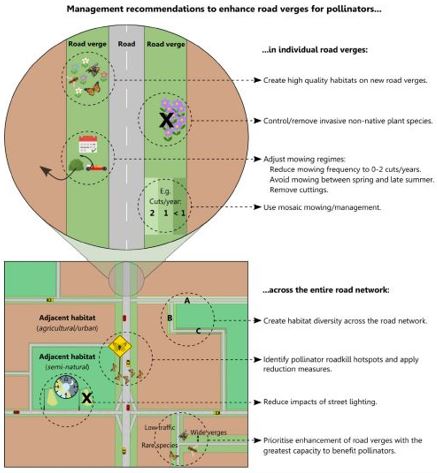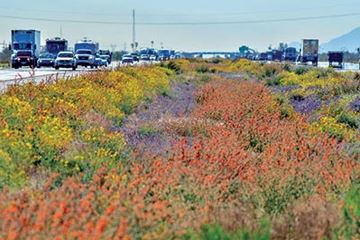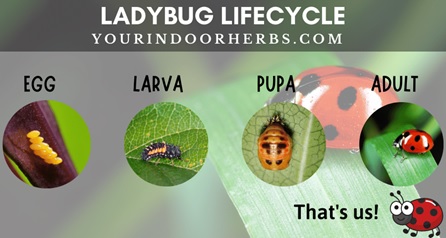Verges spaces are empty spaces that together add up to a large area with the potential to be used for pollinator (Diptera, Lepidoptera and Coleoptera) promotion, which requires management guidance to determine the floral species as well as provision to reduce collisions with vehicles. Providing shelters for pollinators is strategic as they often nest in fallen tree trunks, rocks or the ground usually removed by human activity.

Management of road verges for pollinators
In addition, in many of these areas, the use of herbicides and pesticides is prohibited (natural parks, nearby streams) and many are located in rural areas close to crops. The creation of these sites is necessary to halt the decline of pollinators and improve the profitability of crops.

Source: https://highways.dot.gov/public-roads/september-2017/save-bees-and-butterflies
The positive aspects are the creation of habitats and corridors essential for the increase of pollinators, stopping their decline, increase of plant species and pollinators are essential for food production and these spaces for the refuge of predators of natural pests.
The negative aspect are roads that cause vehicle-pollinator collisions, pollution, barrier to movements but can be reduced with good management, as benefits of verges to pollinators greatly exceed costs.
Main co-benefits that this solution can provide are: Sustainable and resilient food systems, Improve land use management, Species increase, Pollinator increase, Increase ecological connectivity, Reduced risk of epidemics, Reduce ecological footprint and Green awareness.
Pollinator and verges spaces are directly related to solutions such as urban water cycle, rainwater management and retention, urban carbon storage and sequestration solutions, and water interventions, as well as all plant-based (NBS) solutions.
Climate and Geography:
Pollinator spaces can be implemented anywhere, preferably using autochthonous flora with different flowering periods an overall adapted to the space and especially taking into account the conditions at the site where the plants will be located, i.e. paying attention to hardiness zone, soil type, sunlight and rain data, frost schedules and other factors that affect the correct development of plants.
Urban form and layout:
Pollinator and Verges spaces are able in empty spaces formed between infrastructures created as fragmentation of open spaces as impact of urbanisation reused for biodiversity conservation. Increased fragmentation of green in urbanized areas can reduce intra- and inter-species connectivity and lead to a loss of biodiversity (Kettunen et al., 2007).
Technical aspects/infrastructure:
A Green Infrastructure approach, linking parks and other green spaces, is therefore considered essential for the preservation of biodiversity and to counter further habitat fragmentation and increase connectivity (Sylwester, 2009).
Policy and regulatory/legal framework / Funding and financing:
In the EU it can be found within the European Green Deal and the Common Agricultural Policy. It also falls within the Parks and Gardens competences of the different institutions.
Economic and social context:
Pollinators play a very important role in society and in the economy, not only to produce honey, but also for the reproduction of many wild plants and for the improvement of the production of many crops, both for human consumption and for animal feed, which is then consumed by humans.
Project governance and implementation modalities:
This infrastructure can be of any size from a few centimetres to kilometres, can be placed horizontally or vertically, on rooftops, on roundabouts in the middle of the city or on highways and rail tracks. These zones can also be designed to restore a degraded area as well as to prevent soil erosion and landslides or to reclaim degraded agricultural land.
The belief that pollinators are undesirable insects causes them to be mistaken for pests, and they are unaware of the different stages of growth, such as caterpillars to form butterflies, eggs and different forms of ladybirds, among others.

Ladybug lifecycle. Source: yourindoorherbs.com
Some of the actions to protect pollinators is not to mow so that some believe it is a neglected space
There is also the problem of space, they must be able to connect with each other with less than 1 km of separation so that the smaller pollinators can move around, so it is necessary to install numerous and different: trees, planters, among others; always with the right conditions of light, soil, etc
This leads to the problem that some of them need an irrigation system for plants and water sources for pollinator
Europe, in special Spain, has a huge variety of insects, most of them pollinate crops and wild plants. Pollinators are essential for healthy food and nature so is close to our better wellbeing. However, deforestation, pollution and other man-made problems have caused that population of wild-insect pollinators such as bees, butterflies, hoverflies and moths have dramatically declined. (IPBES, 2016; Potts et al., 2010; Vanbergen et al., 2013)
Pollinator spaces can offer much-needed habitat for pollinators, providing food, shelter, and connections to other patches of habitat, for instance, roadsides is a significant conservation opportunity.
- Technical Manual for Maintaning Roadsides for Pollinators
- Public Roads - Save the Bees and Butterflies (conservation of pollinators)
It is difficult to measure the impact of NBS for pollinators as it depends very much on their size, location and composition, as well as their maintenance, and it is impossible to give a numerical value, but it is possible to say that the increase of green areas with autochthonous flowering plants has a direct positive impact.
Pollination in food system is valued between €153 and 505 billion per annum worldwide (Gallai, Salles, Settele, & Vaissiere, 2009; Lautenbach, Seppelt, Liebscher, & Dormann, 2012).
Insect pollinator conservation is asociated with public engagement in no-honeybees (Bhattacharyya, Acharya, & Chakraborty, 2017; Schonfelder & Bogner, 2017; Sumner, Law, & Cini, 2018; Wilson, Forister, & Carril, 2017)
For pollinators, local vegetation attributes such as richness and the abundance of flowers are very important, often it is more important than the surrounding landscape (Bergman et al., 2008; Pardee and Philpott, 2014)
For pollinators, the continuity of food resources over time is extremely important. The availability of suitable, flowering food plants throughout the growing season can enhance the survival, development, and reproduction of these beneficial insects (Bowers, 1986; Lehtila and Syrjanen, 1995; Kearns and Inouye, 1997; Vaudo et al., 2015).
Educational activities on NBS, Educational/ Capacity building barriers identification: The word pollinator is often understood to mean a stinging insect, so the word "pollinator" is often used to mean an insect that stings, it is better to use names referring to flowers and plants, as the implementation is about increasing the density of autochthonous nutritious flowers.
Capacity building for city officials to understand urban metabolisms and circular solution opportunities: The European Environmental Programme States that in 2020 “Cities in the Union are implementing policies for sustainable urban planning and design” “that asses the environmental performance of cities considering economic, social and territorial impacts”. NBS
Engagement, co-creation and co-design of NBS and Green Infrastructure plans and interventions: Incentives, Citizen participation, spaces for knowledge and co-creation: Final users need to understand these actions to accept it and be part of them with active participation (planting or sowing).
NBS and Green Infrastructure regulation and ordinances: Sanctions, reduce acts of incivility by people tearing up plants, using them as ashtrays or dustbins, among other actions.
Integrated land use and urban planning with energy and climate: Pollinator avtions are in an urban environment an innovative way to meet urban environmental and sustainability policy targets.
- Pollinators’ modules in Valladolid (Spain): https://www.urbangreenup.eu/solutions/natural-pollinators-modules.kl
- Ireland Pollination Plan: https://pollinators.ie/
- Butterfly conservation: https://butterfly-conservation.org/
- Pollinator partnership: https://pollinator.org/
Comments ()